Expert Guide on How to Clean and Season Your Cast Iron Pan for Longevity

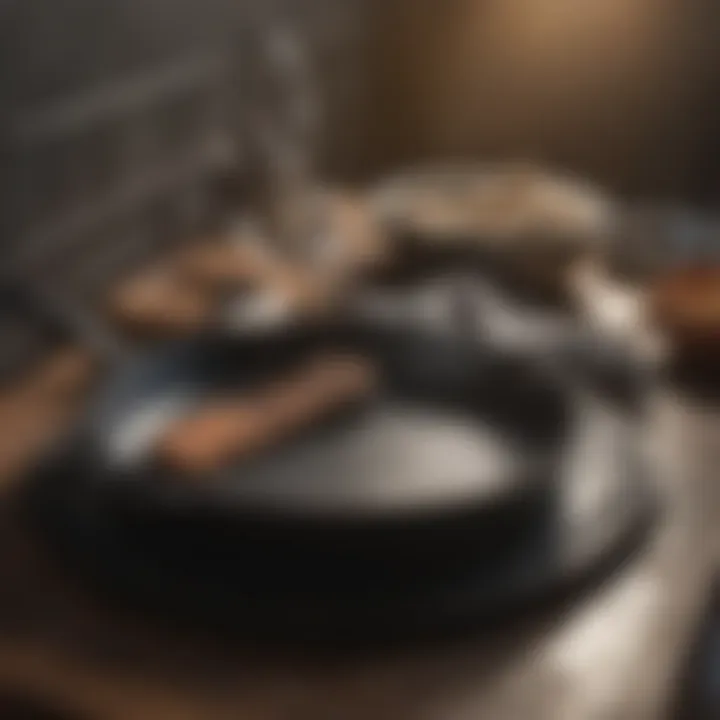
Cast iron pans are prized for their durability and versatility in the kitchen. To ensure your cast iron pan lasts for generations and maintains its non-stick surface, proper cleaning and seasoning are paramount. This comprehensive guide will walk you through the steps to tackle this essential maintenance routine.
Cleaning Your Cast Iron Pan
Step 1: Scrubbing
Begin by rinsing the pan with hot water and using a stiff-bristled brush to scrub off any food residue. Avoid using soap as it can strip the pan's seasoning.
Step 2: Drying
Thoroughly dry the pan with a towel or by placing it on the stove over low heat to evaporate any remaining water to prevent rusting.
Step 3: Removing Stubborn Residue
For stubborn residues, create a paste of coarse salt and water, apply it to the pan, and scrub gently to loosen the stuck-on bits.
Step 4: Re-seasoning
After cleaning, it's crucial to re-season the pan to restore its non-stick surface and prevent rusting. Apply a thin layer of oil to the pan inside and out, then place it in an oven preheated to 375°F for one hour. Allow it to cool before storing.
Seasoning Your Cast Iron Pan
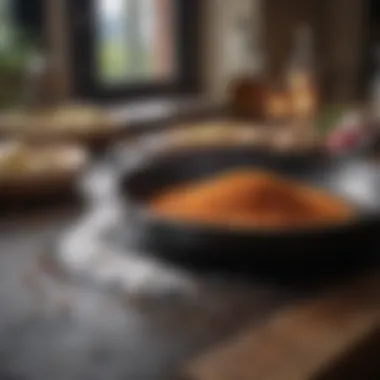
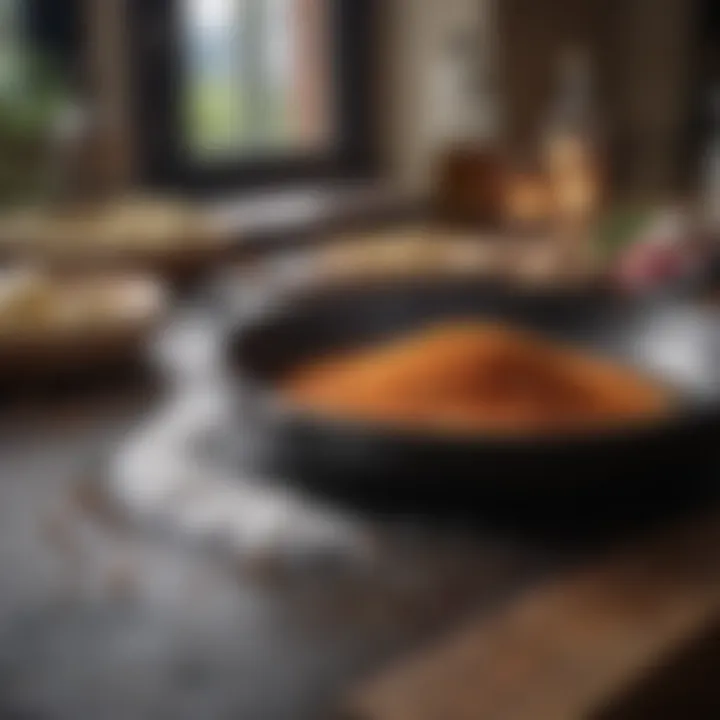
Step 1: Choosing the Right Oil
Select a high smoke-point oil like flaxseed or grapeseed oil for seasoning your cast iron pan to create a durable, non-stick finish.
Step 2: Applying the Oil
Using a paper towel, apply a thin layer of oil to the entire pan, including the handle, bottom, and outer walls.
Step 3: Baking the Pan
Place the pan upside down in an oven preheated to 400°F with a sheet of aluminum foil on the rack below to catch any drips.
Step 4: Cooling and Storing
Leave the pan in the oven for an hour, then turn off the oven and let the pan cool inside. Once cooled, your cast iron pan is ready to use or store.
By following these meticulous steps, you can guarantee the longevity and performance of your beloved cast iron pan, making it a cherished kitchen companion for years to come.
Introduction
In the realm of culinary expertise, the humble cast iron pan holds a prestigious position. It is not merely a cooking utensil, but a cherished tool that transforms ordinary ingredients into extraordinary dishes. This article embarks on a journey to unveil the intricate art of cleaning and seasoning a cast iron pan, thereby enhancing its longevity and culinary performance. By delving into the nuances of maintaining this culinary essential, readers will discover the profound impact of adequate care on their cooking experience.
Understanding the Importance of Cleaning and Seasoning
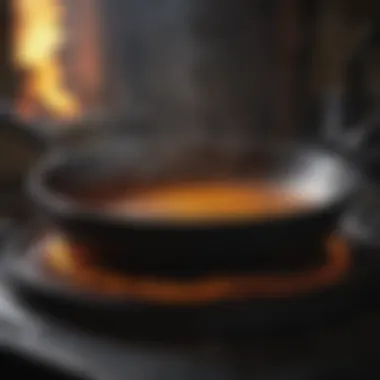
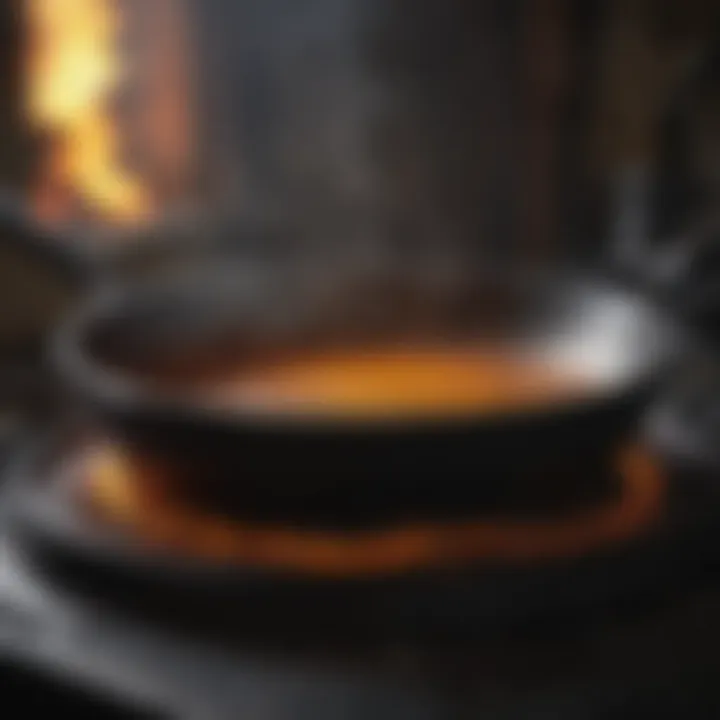
Navigating the labyrinth of cast iron care necessitates a profound understanding of the pivotal roles played by cleaning and seasoning. These processes are not mere chores but essential rituals that safeguard the pan's integrity and elevate its functionality. Cleaning strips away the vestiges of previous culinary escapades, ensuring a fresh canvas for your next masterpiece. Conversely, seasoning creates a protective patina, imbuing the pan with non-stick properties and unique flavor-enhancing capabilities. Together, these practices form the cornerstone of cast iron maintenance, safeguarding its utility and resilience against the rigors of time and heat.
The lore of cast iron transcends mere cooking; it encapsulates tradition, resilience, and culinary finesse. With each sizzle and sear, the pan absorbs the flavors of the past, infusing them into future creations. To neglect its care is to disregard a lineage of flavors and stories, passed down through generations. Thus, grasping the essence of cleaning and seasoning is not merely a matter of maintenance but a celebration of culinary heritage, where the past meets the present in a harmonious blend of flavors and textures.
Cleaning Your Cast Iron Pan
In the realm of cast iron cookware maintenance, cleaning your cast iron pan holds paramount significance. This essential practice ensures the longevity and performance of your culinary companion. By delving into a meticulous cleaning routine, you not only eradicate food residue but also prevent the onset of rust and maintain the pan's seasoned surface that enhances flavor profiles.
Gentle Cleaning Methods
When considering gentle cleaning methods for your cast iron pan, opting for non-abrasive tools such as sponge or brush proves instrumental. Utilizing warm water and a mild detergent facilitates the removal of stuck-on food particles without compromising the seasoning. Gently scrubbing the surface with a soft cloth effectively cleanses the pan without stripping off the seasoned layer, ensuring its non-stick properties endure.
Avoiding Harsh Chemicals
Straying away from harsh chemicals when cleaning your cast iron pan is imperative to preserve its integrity and seasoning. Abrasive cleaners and harsh chemicals can erode the seasoned layer, rendering your pan vulnerable to rust and diminishing its non-stick capabilities. Opt for natural cleaning agents like baking soda or vinegar to maintain the pan's seasoned surface while safeguarding its longevity and performance.
Drying Thoroughly
After cleansing your cast iron pan, ensuring thorough drying is a critical step in preventing rust formation. Thoroughly drying the pan with a clean towel and placing it on a stovetop over low heat facilitates evaporation of any remaining moisture. Adequate drying not only prevents rust but also prepares the pan for the subsequent seasoning process, allowing the oil to adhere effectively and maintain the pan's non-stick properties.
Seasoning Your Cast Iron Pan
In the realm of cast iron cookware maintenance, seasoning your pan is a crucial step that should not be underestimated. Seasoning involves building up a natural, non-stick layer on the surface of the pan through the polymerization of oil. This process not only enhances the cooking performance of the pan but also prevents rusting and improves its durability over time. By seasoning your cast iron pan regularly, you are essentially creating a protective barrier that adds flavor to your dishes and promotes even heat distribution.


Using Oil or Shortening
When it comes to seasoning your cast iron pan, selecting the right oil or shortening is paramount for achieving optimal results. Oils that have a high smoke point such as vegetable oil, canola oil, or flaxseed oil are commonly recommended for seasoning cast iron pans. The choice of oil can influence the effectiveness and longevity of the seasoning, so it is essential to pick one that best suits your cooking preferences. Additionally, shortening, known for its ability to create a durable seasoning layer, is another popular option for seasoning cast iron pans. Whichever option you choose, ensure to apply a thin, even layer of oil or shortening to the entire surface of the pan to facilitate the seasoning process.
Even Coating Method
Achieving an even coating of oil or shortening on your cast iron pan is key to establishing a uniform seasoning layer. Start by heating your pan to open up its pores, making it more receptive to the seasoning. Next, using a paper towel or a brush, apply a thin layer of oil or melted shortening to the interior and exterior of the pan. Ensure that the oil is spread evenly without pooling in any particular area. Excess oil can lead to a sticky residue on the pan, so it's important to wipe off any surplus oil before proceeding to the next step.
Applying Heat
Once you have applied the oil or shortening, it's time to apply heat to your cast iron pan to lock in the seasoning. Place the pan upside down in a preheated oven at a specified temperature, usually around 375-400°F (190-200°C). Heating the pan at this temperature allows the oil to polymerize, forming a hard layer that bonds with the pan's surface. Let the pan bake for a couple of hours, ensuring that any excess oil drips off. After cooling down, your cast iron pan should have a well-seasoned coating that is ready for use. This process may need to be repeated periodically to maintain the seasoning and prolong the life of your cast iron cookware.
Maintaining Your Seasoned Cast Iron Pan
In this section, we delve into the crucial aspects of maintaining a seasoned cast iron pan to ensure its longevity and optimal performance. A well-maintained cast iron pan not only enhances the flavor of your dishes but also prolongs the life of your cookware investment. Proper maintenance involves a series of thoughtful practices that can significantly impact the quality of your cooking.
One of the fundamental principles of preserving your seasoned cast iron pan is avoiding soaking. Soaking can lead to rust and damage the seasoning you have painstakingly built up over time. It's crucial to emphasize that soaking cast iron pans can result in the loss of their natural non-stick properties and even compromise the integrity of the metal itself.
To counteract the effects of soaking, regular re-seasoning is essential. Re-seasoning refers to the process of applying a fresh layer of oil to your pan to maintain its non-stick surface and protective coating. When you notice signs of wear and tear on the seasoning of your cast iron pan, prompt re-seasoning can help restore its functionality and extend its lifespan.
Moreover, utilizing wooden utensils when cooking with your cast iron pan is highly recommended. Wooden utensils help prevent scratches on the pan's surface, preserving the seasoning and ensuring a longer life for your cookware. Unlike metal utensils that can chip away at the seasoning, wooden utensils gently interact with the surface, safeguarding the non-stick properties of your pan.
Conclusion
In essence, mastering the art of cleaning and seasoning your cast iron pan is imperative for maintaining its longevity and ensuring optimal cooking performance. By following the meticulous steps outlined in this article, you can safeguard your cast iron cookware investment for years to come. The attention to detail in the cleaning process, paired with the precise application of seasoning techniques, is not just about aesthetics but also about enhancing the flavor of your dishes. Remember, a well-maintained cast iron pan is not just a piece of cookware; it is a culinary asset that can elevate your cooking experience.
Benefits of Proper Maintenance
Delving into the depths of properly maintaining your seasoned cast iron pan reveals a myriad of benefits that go beyond just cleanliness. First and foremost, a well-seasoned pan creates a natural non-stick surface, reducing the need for excessive oils and fats in cooking. This not only promotes healthier eating but also allows the natural flavors of your ingredients to shine through without any unwanted residues. Moreover, by avoiding soaking your cast iron pan and opting for gentle cleaning methods, you preserve its seasoning, preventing rust and ensuring its durability. Additionally, the act of re-seasoning as needed serves as a form of care and rejuvenation for your pan, prolonging its lifespan. Finally, utilizing wooden utensils instead of metal tools helps in preventing scratches and maintaining the integrity of the seasoning. In essence, the benefits of proper maintenance extend far beyond just the appearance of your cookware; it impacts the quality of your culinary creations and the joy derived from using a well-preserved cast iron pan.



